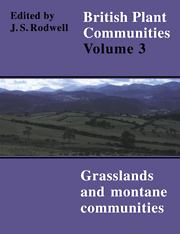Book contents
- Frontmatter
- Contents
- List of Figures
- Preface and Acknowledgements
- Preamble
- Mesotrophic Grasslands
- Community Descriptions
- Calcicolous Grasslands
- Community Descriptions
- Calcifugous Grasslands and Montane Communities
- Community Descriptions
- Index of Synonyms to Grasslands and Montane Communities
- Index of Species in Grasslands and Montane Communities
- Bibliography
U14 - Alchemilla Alpina-Sibbaldia Procumbens Dwarf-Herb Community
Published online by Cambridge University Press: 04 July 2020
- Frontmatter
- Contents
- List of Figures
- Preface and Acknowledgements
- Preamble
- Mesotrophic Grasslands
- Community Descriptions
- Calcicolous Grasslands
- Community Descriptions
- Calcifugous Grasslands and Montane Communities
- Community Descriptions
- Index of Synonyms to Grasslands and Montane Communities
- Index of Species in Grasslands and Montane Communities
- Bibliography
Summary
Synonymy
Alchemilla-Sibbaldia nodum McVean & Ratcliffe 1962.
Constant species
Agrostis capillaris, Alchemilla alpina, Deschampsia cespitosa, Galium saxatile, Nardus stricta, Omalotheca supina, Sibbaldia procumbens, Thymus praecox, Viola palustris, Polytrichum alpinum.
Rare species
Cerastium alpinum, Euphrasia frigida, Minuartia sedoides, Sagina saginoides, Sibbaldiaprocumbens, Aulacomnium turgidum, Hypnum hamulosum, Moerckia blyttii.
Physiognomy
The Alchemila alpina-Sibbaldiaprocumbens community has a very low and often somewhat open turf in which matand cushion-forming herbs, tussocky grasses and moss patches provide the most distinctive elements. The composition can be quite diverse, but Alchemilla alpina and the nationally rare Sibbaldia procumbens are constant throughout and are usually among the most abundant species, with Thymus praecox also very common and of locally high cover. Occasionally, too, the velvety cushions of Silene acaulis can be found, but the general scarcity of this plant here is one good distinguishing feature separating this vegetation from the rather similar carpets of the Festuca-Alchemilla-Silene community, where it is the typical dominant. Among the grasses, Nardus stricta, Agrostis capillaris, Festuca ovinalvivipara and Deschampsia cespitosa (including some obvious ssp. alpina) are all found very frequently, usually growing as scattered tussocks but together often making a sizeable contribution to the cover. D. cespitosa in particular can attain considerable abundance here and, where it thickens up, this may presage a switch to more species-rich stands among the related Deschampsia-Galium community. Anthoxanthum odoratum, Deschampsia flexuosa and Agrostis canina also occur quite commonly, though with only modest local abundance, and there is often a little Carex bigelowii and Luzula spicata with occasional C. pilulifera and Juncus trifidus.
Scattered through the sward are frequent plants of Omalotheca supina, Viola palustris, Euphrasia officinalis agg. (including the rare E. frigida) and Galium saxatile, the constancy of the last being another good difference from the Festuca-Alchemilla-Silene community. Selaginella selaginoides, by contrast, is not quite so common as in that more generally calcicolous vegetation, and Saxifraga oppositifolia, which is rather frequent there, is hardly ever found in the Alchemilla-Sibbaldia community. Quite common here, though, are Potentilla erecta, Polygonum viviparum, Cerastium fontanum, Ranunculus acris, Thalictrum alpinum, Huperzia selago and Minuartia sedoides', and there is sometimes also a very little Salix herbacea and Vaccinium myrtillus, but dwarfor sub-shrubs are not a characteristic feature here.
- Type
- Chapter
- Information
- British Plant Communities , pp. 440 - 445Publisher: Cambridge University PressPrint publication year: 1992

